Hepatology > EXAM > NRNP 6560 Midterm exam with complete solutions (All)
NRNP 6560 Midterm exam with complete solutions
Document Content and Description Below
Surgery risk classes - ANSWER Class 1: benefits outweigh risk, should be done Class 2a: reasonable to perform Class 2b: should be considered Class 3: rarely appropriate General rules for surgery... : testing - ANSWER ECG before surgery only if coronary disease, except when low risk surgery Stress test not indicated before surgery Do not do prophylactic coronary revascularization Meds before surgery - ANSWER - Diabetic agents: Use insulin therapy to maintain glycemic goals(iii) Discontinue biguanides, alpha glucosidase inhibitors, thiazolidinediones, sulfonylureas, and GLP-1 agonists - Do not start aspirin before surgery - Stop Warfarin 5 days before surgery. May be bridged with Lovenox. - Do not stop statin before surgery - Do not start beta-blocker on day of surgery, but may continue Assessment of surgical risk - ANSWER - Unstable cardiac condition (recent MI, active angina, active HF, uncontrolled HTN, severe valvular disease), concern with CAD, CHF. arrhythmia, CVD - patient stable or unstable? - urgency of the procedure (oncology will be time sensitive) - risk of procedure - nutritional status - immune competence - determine functional capacity (need to be more than 4 METS, more than 10 METs makes low risk) Low risk surgeries - ANSWER catarcts breast biopsy cystoscopy, vasectomy laporascopic procedures Plastic surgery intermediate risk surgeries - ANSWER Head/ neck surgery thyroidectomy Intraperitoneal Prostate Laminectomy Hip/ knee Hysterectomy cholecystectomy nephrectomy non majot intrathoracic High risk surgeries - ANSWER aortic/ cabg transplants spinal reconstruction peripheral vascular surgery Lee's revised cardiac risk index - ANSWER 6 points: High risk surgery = 1 CAD = 1 CHF = 1 Cerebrovascular disease = 1 DM 1 on insulin = 1 Creat greater than 2 = 1 1 = low risk 2 = moderate risk 3 = high risk SCIP pre-operative infection measures - ANSWER - Prophylactic antibiotics should be received within 1 h prior to surgical incision - be selected for activity against the most probable antimicrobial contaminants - be discontinued within 24 h after the surgery end-time Postoperative infection reduction methods - ANSWER - pre-op hair removal (clippers) - wash hands - normothermia - maintain euglycemia - urinary catheters are to be removed within the first two postoperative days Osteoarthritis: what, incidence - ANSWER Slow destruction of bones/ joint followed by production of replacement collagen which causes inflammatory changes - older than 60 - more female after 55 - more black than white women - men and women equal risk between 45 - 55 - abnormal height or weight (obesity) - repetitive movement - prior trauma (sprains/ dislocations) - diabetic neuropathy - genetic Osteoarthritis findings and diagnostics - ANSWER - Pain in weight bearing joints - stiffness after sitting, gets better when arising - feeling of instability on stairs - fine motor skills deficit - larger affected joints - Heberden nodules (bony bumps on the finger joint closest to the fingernail) - Bouchard's nodules (bony bumps on the middle joint of the finger) - limited ROM with crepitus - xr shows narrowing of joint space (need anteroposterior and lateral knee films bilaterally) - synovial fluid is clear and without WBC Osteoarthritis treatment - ANSWER Goal is to relieve symptoms, maintain/ improve function, and avoid drug toxicity Hand OA: - rest/ joint protection, with splinting - heat/ cold therapy - topical capsaicin - topical NSAID (trolamine salicylate) (especially for older than 75) - Oral NSAIDS, incl COX2 inhibitors such as celecoxib (Celebrex) (may cause cardiac problems) - tramadol - no opioids Hip/ knee OA: - weight reduction, cardiovascular exercises - transcutanous external nerve stimulator - acetaminophen - Topical NSAIDS (knee) - intraarticular corticosteroid injections - surgery (joint replacement) Rheumatoid arthritis: what, who - ANSWER chronic, systemic autoimmune disease that causes inflammation of connective tissue, first that of jionts them other soft tissues (renal, cardiovascular, pulm). TNF-alpha plays a big role - more women than men - unknown cause - Epstein Barr virus Rheumatoid arthritis: Findings and diagnostics - ANSWER - symmetric joint/ muscle pain, worse in the morning then gets better - weakness, fatigue - anorexia, weight loss - generalized malaise - swollen joints/ boggy feeling of joints with deformity of joints - warm, red skin on affected joints later: - pleural effusions and pulmonary nodules - inflammation of sclerea (scleritis) - pericarditis, myocarditis - splenomegaly (Felty's syndrome) - anemia (hypochromic, microcytic) with low ferritin - possibly: positive rheumatoid factor - XR: joint swelling, later cortical and space thinning - synovial fluid: yellow, thick with elevated WBC up to 100.000 Felty's syndrome - ANSWER rheumatoid arthritis, splenomegaly, neutropenia Rheumatoid arthritis treatment - ANSWER - early treatment better than stepwise - early referral rheumatologist - disease-modifying anti-rheumatic drugs (DMARDs): - methotrexate ( no alcohol, monitor renal and liver, give with folic acid) - cyclosporine - Gold preparations (can cause thrombocytopenia) - Hydroxychloroquine: antimalarial drug (may cause visual changes, monitor) - sulfasalazine, moderate RA - Leflunomide, moderate to severe RA - Etanercept - monitor liver function with DMARDs - screen for TB (skin test) and Hep B - surgery: joint debridement, joint replacement Gout: what, who - ANSWER Inflammatory disorder in response to high uric acid production/ levels in blood and synovial fluid causing crystallization which causes inflammation (Type A and Mediterranean) - impaired renal function which causes excess uric acid - foods high in purine, such as dairy, red meat, shellfish, beer Gout findings, diagnostics - ANSWER - acute painful joint, often great toe (warm, swollen) - pain at night - flank pain because of renal calculi - fever - leukocytosis - elevated erythrocyte sedimentation rate - tophi (bump under skin) on ear - limited joint motion - elevated serum uric acid (greater than 7mg/dl) - urate crystals seen with joint aspiration - xr: joint erosion and renal stones Gout treatment - ANSWER - NSAIDS: naproxen, ondomethacin, sulindac - Colchicine for those who do not tolerate NSAIDS (caution with renal impairment). Also for prophylaxis - Corticosteroids, if NSAIDS and colchicine not tolerated - 24hr urine for uric acid - Allopurinol after flare is over (100mg PO daily) - Biological modifiers of disease (BMD): Pegloticase. Not for asymptomatic. Treat with prophylaxis first. Monitor serum uric acid ANA. Tests in rheumatic disease: what, normal level, abnormal with. - ANSWER Antinuclear antibody (ANA). Normal: Titer 1.32 POsitive with: Sjogren's (SS), SLE (lupus), C4 Complement. Tests in rheumatic disease: what, normal level, abnormal with. - ANSWER Determines hemolytic activity which speaks to level of inflammatory response Normal: men: 12-72. Women: 13-75 mg/dl Increased with: inflammatory disease Decreased with: RA, lupus, SS The radioallergosorbent test (RAST). Tests in rheumatic disease: what, normal level, abnormal with. - ANSWER measures presence/ increase antigen IgE normal: 0.01 - 0.04 mg/dl Increased with allergic reaction Erythrocyte sedimentation rate (ESR). Tests in rheumatic disease: what, normal level, abnormal with. - ANSWER rate at which RBC settle out of unclotted blood in 1 hr Normal: men: 0-7mm/hr, women: 0 - 25 mm/hr Increased with inflammation CRP. Tests in rheumatic disease: what, normal level, abnormal with. - ANSWER C-reactive protein, a non-specific antigen antibody Normal: trace to 6mg/ml Increased with infection and inflammation, RA. Decreased with succesfull RA treatment RF. Tests in rheumatic disease: what, normal level, abnormal with. - ANSWER Rheumatoid factor. antibody against IgG. Positive RF in most people with RA Corticosteroids and arthritis: what does it do and adverse effects - ANSWER Not for maintenance Use lowest dose Suppresses flares nausea, hyperglycemia, weight gain, adrenal insufficiency, mask infections NSAIDS and arthritis: what and adverse effects - ANSWER analgesic and anti-inflammatory give PPI concurrently to prevent GI complication Headache, htn, fluid retention, n/v, ulcers/ bleeding, abnormal liver function tests, rash, renal insufficiency Celebrex and Arthritis - ANSWER Analgesic and anti-inflammatory Fewer ulcers than with other NSAIDS Not recommended in renal or liver failure Screen for sulfa allergy May cause cardiovascular thrombotic event May cause GI adverse event subluxation: what, cause - ANSWER partial dislocation of a joint. Common sites: shoulder, elbow, wrist, hip, knee, patella, ankle, spine trauma, blunt force neuromuscular disease inflammatory joint disease, RA Loose ligaments Ehlers-Dantos syndrome (loose ligaments and overflexible joints- congenital) Findings and diagnostics subluxation - ANSWER Pain over affected area previous subluxation swelling around joints loss of ROM XR, CT, MRI show subluxation Increased WBC (stress response) Management of subluxation - ANSWER Early reduction, many spontaneously immobilization (splint, sling) PT NSAIDS for pain/ swelling Dislocation: what, cause - ANSWER Complete displacement of bone end and position in joint. Common sites: shoulder, elbow (nurse maid), wrist, hip, knee (emergency if loss of integrity of ACL and PCL), ankle/ foot high energy blunt force trauma congenital neuromuscular disorder inflammatory joint disease, RA Loose ligaments younger than 35 often, due to sports Often associated with fracture Findings and diagnostics dislocation - ANSWER severe pain over affected area hx of mechanism of injury numbness/ tingling distal to injury joint deformity shortened limb contusion/ laceration over affected joint decreased pulses distal to joint decreased rom decreased sensation distally due to nerve damage WBC elevated due to stress Hgb may be low due to bruising xr: dislocation (should get anteroposterior) CT scan for pelvic trauma to rule out hip/ pelvic fracture Order ultrasound for posterior knee dislocation: high incidence of popliteal artery injury McMurray test, Lachman Test, straight leg test - ANSWER McMurray: turn foot and bend knee. Positive with Meniscus injury Lachman test: Hold upper and lower leg, around knee, stretch. Hyperstretch: ACL injury Straight leg test: Pain when raising leg, while supine. Positive for herniated disk. Dislocation management - ANSWER Early reduction is essential: closed/ manual if no fracture. If fracture then may need surgery. Postreduction immobilization (splint, cast, sling) surgical repair of ligaments PT/ OT NSAIDS Muscle relaxant for muscle spasms Narcotics for short term use Soft tissue injury: definition, classifications, incidence - ANSWER Injury to non-bony tissue, such as muscle, ligament, tendon, bursa, cartilage, skin Classification: - Closed injury: contusion, hematoma, crush, strain (muscle), sprain (ligament, first to third degree), rupture (muscle and ligaments: instability, inability to move) - Open injury: laceration, abrasion, penetrating/ puncture, amputations trauma exercise/ overuse autoimmune (RA, SLE) obesity age (skin tear elderly) Findings and diagnostics soft tissue injury - ANSWER pain swelling feeling of instability of joint Ruptures/ muscle tear: decreased ROM, immediate swelling and hematoma, abnormal contour muscle, instability of joint, pain/ guarding, watch neurovascular integrity Ligaments/ sprain: pain on palpation and ROM, decreased ROM with moderate swelling, Lachman's test (hypermobile joint is positive sign) Strain/ muscle or tendon: swelling, decreased/ absent ROM, pain/ guarding Cartilage: swelling, click during McMurray's test (would indicate meniscus tear), pain/ guarding Bursa: swelling with boggy feeling, erythema over bursa, decreased ROM Skin: abrasion, laceration, puncture Soft tissue injury findings and diagnostics - ANSWER WBC increased, especially with bursitis Hgb decreased with massive hematoma Synovial fluid aspiration: WBC with inflammation, RBC with bleeding into joint, crystals with gout Xr will reveal swelling MRI (knee/ shoulder) location and degree of injury Soft tissue injury management - ANSWER PRICE (protection, rest, ice, compression, elevation) possible immobilization surgery, if rupture, grade III ligaments sprain, septic bursa, wound closure PT NSAIDS Muscle relaxant Opioids - short term Broad spectrum ab's (cephalexin, cefazolin) Fracture Classification - Gustillo - ANSWER - Closed - Open: Type 1: wound smaller than 1cm Type 2: wound larger than 1cm, moderate contamination Type 3: high degree of contamination, severe fracture instability, soft tissue damage. T3A: soft tissue coverage adequate, T3B: extensive injury soft tissue, exposed bone, T3C: open fracture with arterial injury - Incomplete or complete - stress - traumatic/ pathologic - displaced/ non-displaced Type of fracture lines - ANSWER Transverse Spiral Oblique Comminuted Logtitudinal butterfly segmental impacted Salter-Harris Fracture Classification - ANSWER Concerns growth plate S: straight across growth plate A: Above growth plate L: BeLow growth plate T: Through growth plate R: ERaser of growth plate (Rammed) Cause of fractures - ANSWER Trauma, tumor, osteoporosis, drugs (prednisone), nutritional deficiency (Vit D), neuromuscular disorders Findings and diagnostics of fractures - ANSWER Pain History of traumatic event Neuromuscular dystrophy: headache (autonomic dysreflexia) Deformity of limp Diminished/ absent pulses ecchymosis and swelling xr, always order anteroposterior and lateral CT scan for pelvic and spinal fractures MRI for suspected spinal cord injury Mortise view (leg inward) for ankle to check talus bone oblique films for humerus, femur, ankle DEXA scan to determine degree of osteoporosis Acute Fractures Management - ANSWER - ABC care (Airway, breathing, circulation), musculoskeletal second survey - fluid resuscitation - early reduction of fracture - cover open wounds - surgical irrigation and debridement for open fracture - Ab's: Cefazolin for gram pos. Clindamycin for tetani infection - pain: opioids [Show More]
Last updated: 1 year ago
Preview 1 out of 60 pages
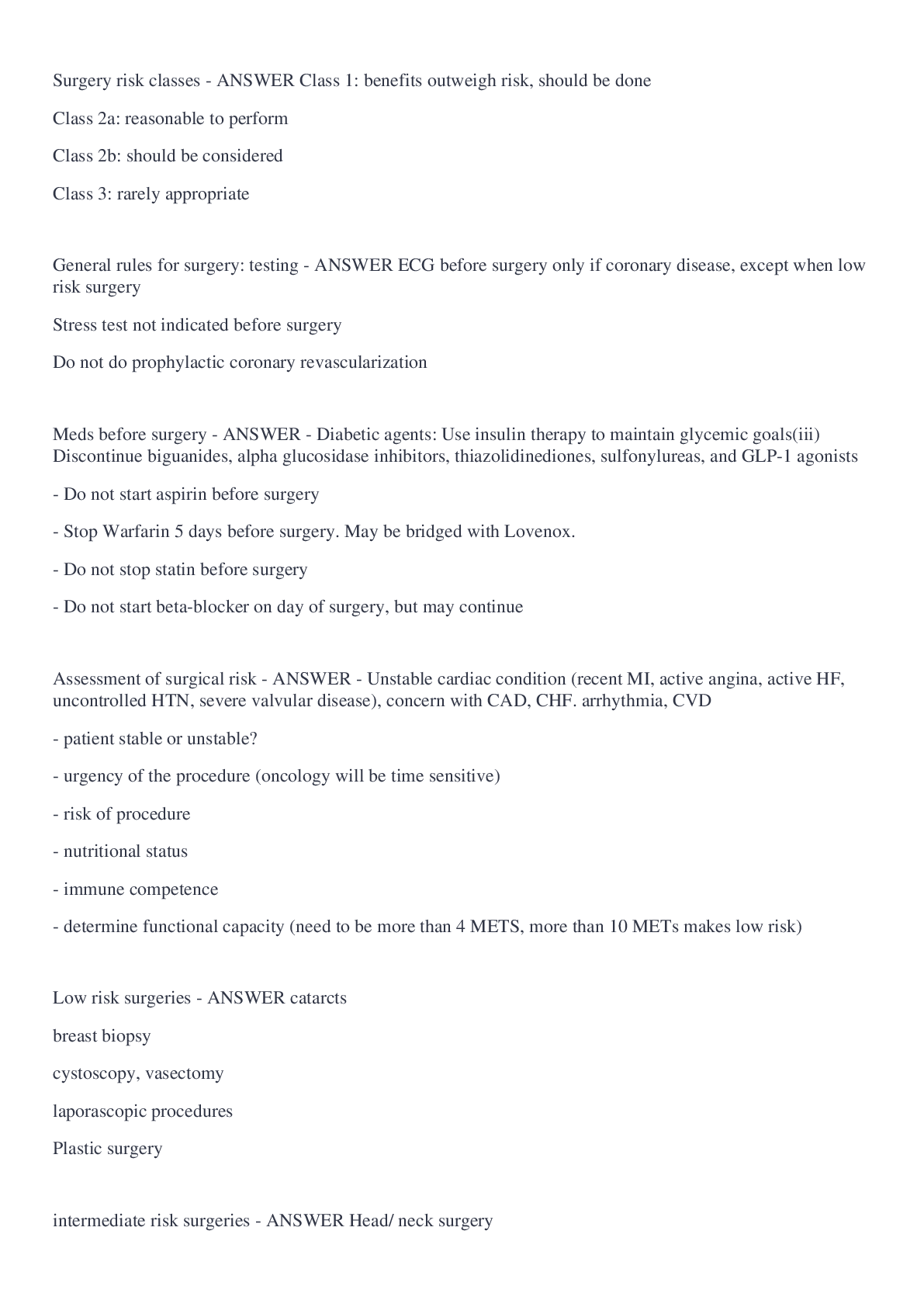
Reviews( 0 )
Recommended For You
*NURSING> EXAM > NR 601 Midterm Exam with correct answers (All)

NR 601 Midterm Exam with correct answers
NR 601 Midterm Exam with correct answers 1. A client is newly diagnosed with type 2 diabetes mellitus. Which diagnostic test will best evaluate the management plan prescribed for this client? Quart...
By tutorcwakuthii , Uploaded: Sep 21, 2023
$10
Procurement> EXAM > PROC 5830 Midterm Exam with Answers (Webster University) > Pricing Study Guide > Guaranteed all Points Correct. (All)

PROC 5830 Midterm Exam with Answers (Webster University) > Pricing Study Guide > Guaranteed all Points Correct.
1. You are considering purchasing a personal computer. What factors would affect your price sensitivity in making the decision? How would those same factors affect the price sensitivity of some person...
By Expert#1 , Uploaded: Sep 21, 2019
$11.5
*NURSING> EXAM > NURS 6560 Policy and Advocacy Walden University. Midterm Exam With Answers Explained. Questions From 55-100. (All)
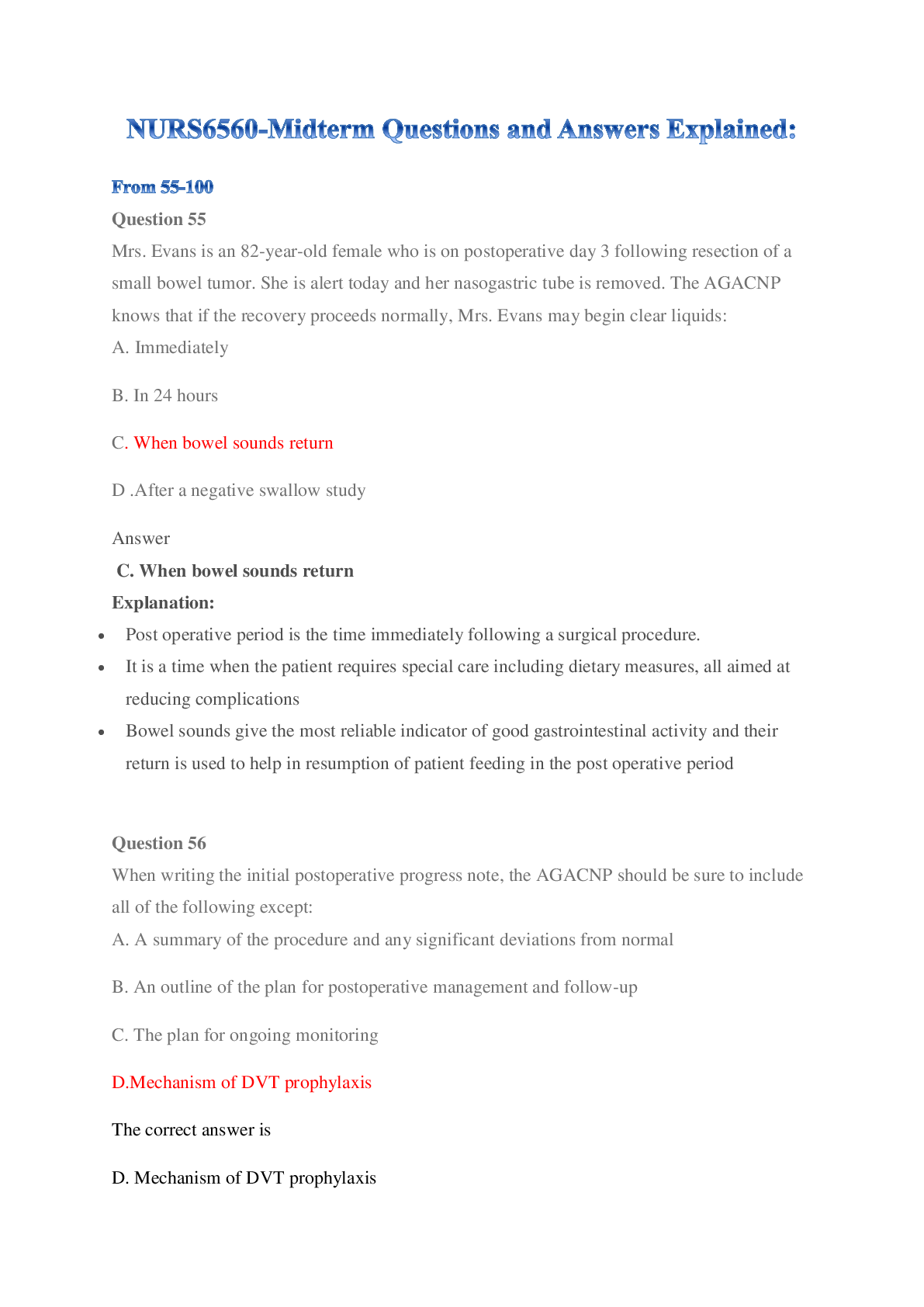
NURS 6560 Policy and Advocacy Walden University. Midterm Exam With Answers Explained. Questions From 55-100.
NURS 6560 Policy and Advocacy Walden University. Midterm Exam With Answers Explained. Question 55 Mrs. Evans is an 82-year-old female who is on postoperative day 3 following resection of a small bowe...
By Kirsch , Uploaded: Mar 31, 2020
$12.5
Health Computing> EXAM > Chamberlain NR599 Midterm Exam with complete solutions (All)
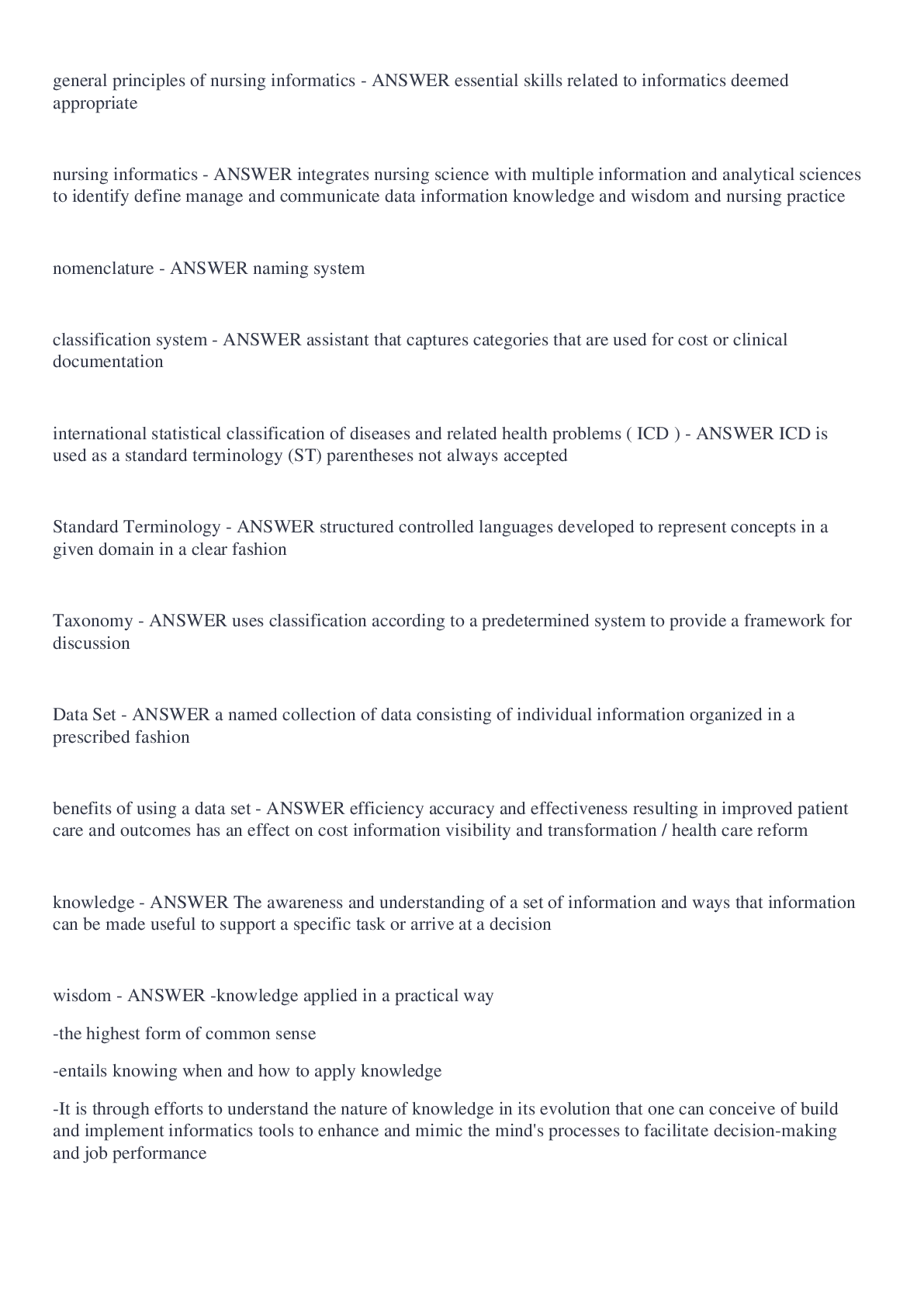
Chamberlain NR599 Midterm Exam with complete solutions
general principles of nursing informatics - ANSWER essential skills related to informatics deemed appropriate nursing informatics - ANSWER integrates nursing science with multiple information and a...
By MARKALLAN , Uploaded: Jul 15, 2022
$8
Hepatology> EXAM > NRNP 6560 Midterm exam with complete solutions (All)

NRNP 6560 Midterm exam with complete solutions
Surgery risk classes - ANSWER Class 1: benefits outweigh risk, should be done Class 2a: reasonable to perform Class 2b: should be considered Class 3: rarely appropriate General rules for surgery...
By Nancylect , Uploaded: Jul 11, 2022
$10
Hepatology> EXAM > NRNP 6560 Midterm exam with complete solutions (All)

NRNP 6560 Midterm exam with complete solutions
Surgery risk classes - ANSWER Class 1: benefits outweigh risk, should be done Class 2a: reasonable to perform Class 2b: should be considered Class 3: rarely appropriate General rules for surgery...
By Nancylect , Uploaded: Jul 11, 2022
$10
Education> EXAM > N6540 Midterm Exam with complete solutions (All)
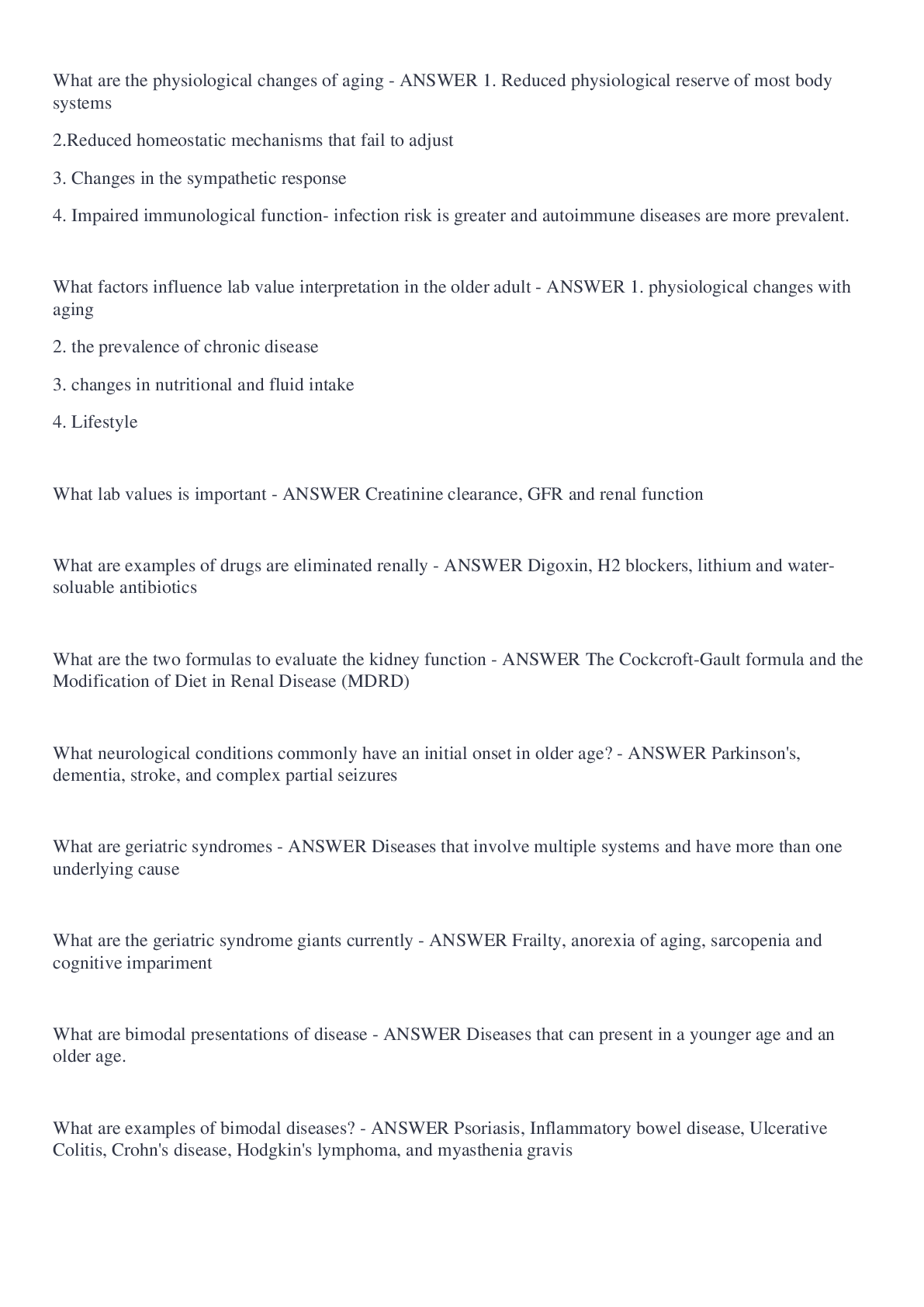
N6540 Midterm Exam with complete solutions
What are the physiological changes of aging - ANSWER 1. Reduced physiological reserve of most body systems 2.Reduced homeostatic mechanisms that fail to adjust 3. Changes in the sympathetic response...
By MARKALLAN , Uploaded: Jul 10, 2022
$8
*NURSING> EXAM > NR 511 Week 4 Midterm Exam with 100% correct Answers | Guaranteed Pass (All)
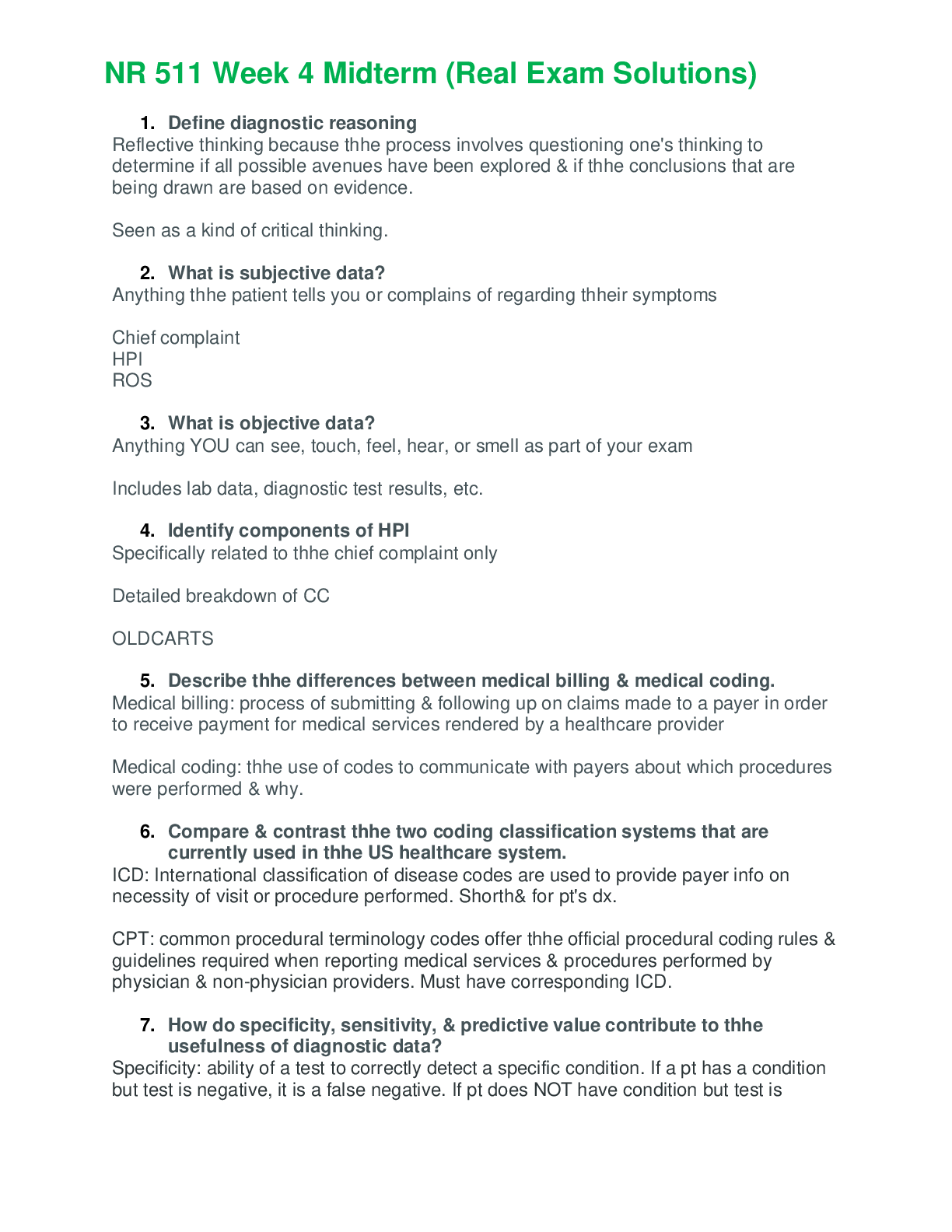
NR 511 Week 4 Midterm Exam with 100% correct Answers | Guaranteed Pass
1. Define diagnostic reasoning Reflective thinking because thhe process involves questioning one's thinking to determine if all possible avenues have been explored & if thhe conclusions that are bein...
By A+ Solutions , Uploaded: Jun 24, 2022
$15
Paediatrics> EXAM > NURS 6541pediatric midterm exam with complete solutions (All)

NURS 6541pediatric midterm exam with complete solutions
NURS 6541pediatric midterm exam with complete solutions NURS 6541pediatric midterm exam with complete solutions NURS 6541pediatric midterm exam with complete solutions NURS 6541pediatric midterm exam...
By DOCTOR BEN , Uploaded: Jun 22, 2022
$14
Health Care> EXAM > NUR 6670 MIDTERM EXAM WITH CORRECT ANSWERS VERIFIED (All)
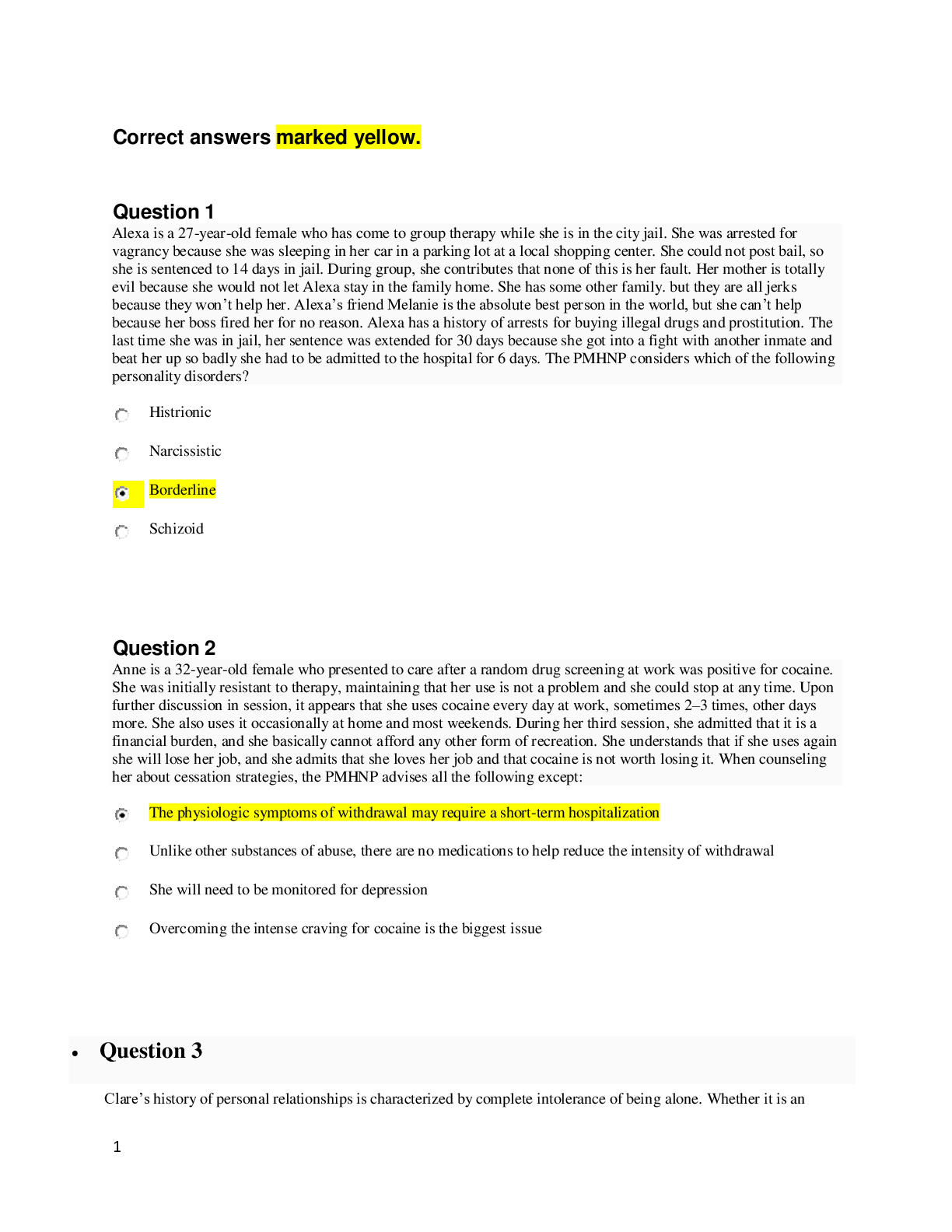
NUR 6670 MIDTERM EXAM WITH CORRECT ANSWERS VERIFIED
NUR 6670 MIDTERM EXAM WITH CORRECT ANSWERS VERIFIEDNUR 6670 MIDTERM EXAM WITH CORRECT ANSWERS VERIFIEDNUR 6670 MIDTERM EXAM WITH CORRECT ANSWERS VERIFIEDNUR 6670 MIDTERM EXAM WITH CORRECT ANSWERS VERI...
By DOCTOR BEN , Uploaded: Jun 21, 2022
$14
Document information
Connected school, study & course
About the document
Uploaded On
Jul 11, 2022
Number of pages
60
Written in
Additional information
This document has been written for:
Uploaded
Jul 11, 2022
Downloads
0
Views
43






